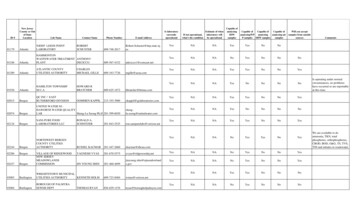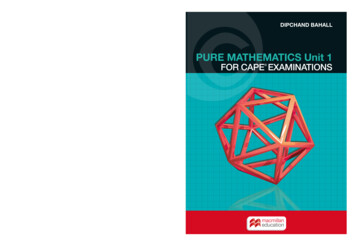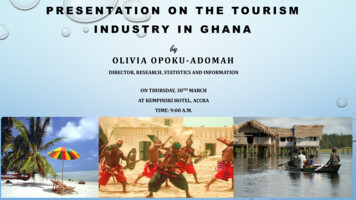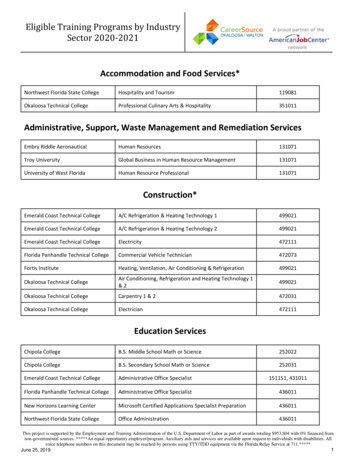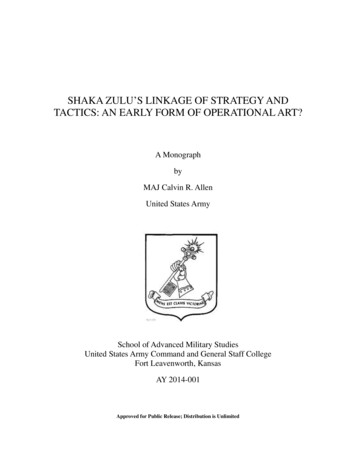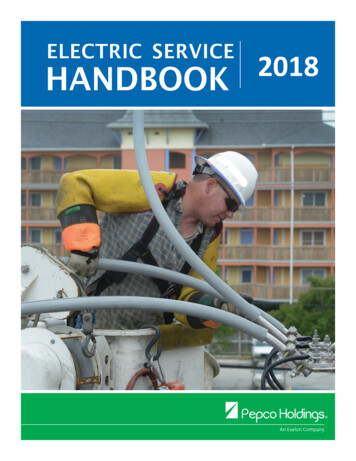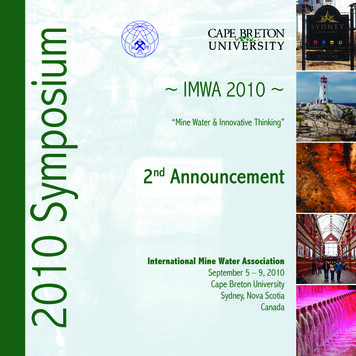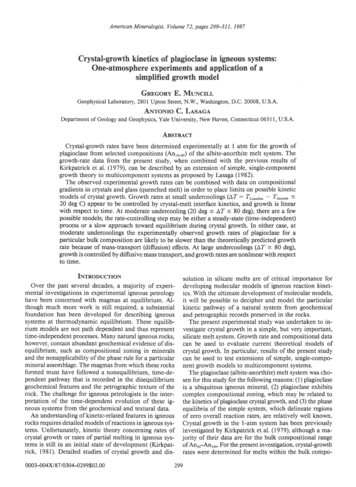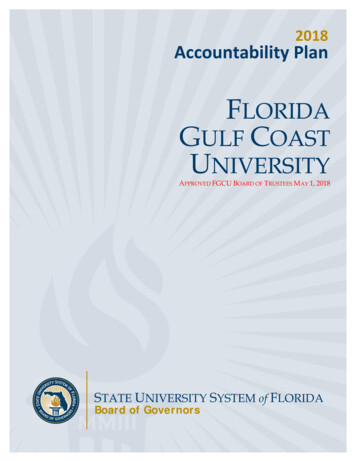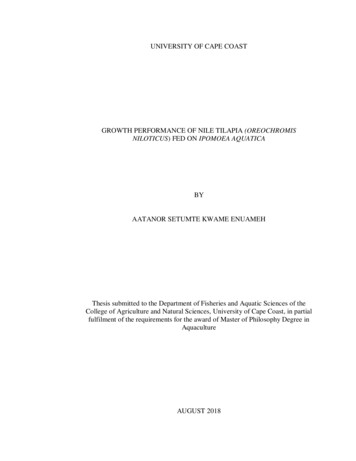
Transcription
UNIVERSITY OF CAPE COASTGROWTH PERFORMANCE OF NILE TILAPIA (OREOCHROMISNILOTICUS) FED ON IPOMOEA AQUATICABYAATANOR SETUMTE KWAME ENUAMEHThesis submitted to the Department of Fisheries and Aquatic Sciences of theCollege of Agriculture and Natural Sciences, University of Cape Coast, in partialfulfilment of the requirements for the award of Master of Philosophy Degree inAquacultureAUGUST 2018
DISCLAIMERThis is to state that the comparator commercial feed used in this study was foracademic purposes only. The researcher had no support whatsoever from thecommercial entity. The mention of the product in this work is in no way anadvertisement, an endorsement or otherwise of the product.ii
DECLARATIONiii
ABSTRACTFeed is one of the major costs of aquaculture operations, constituting between 3070% of the total operating budget depending on the intensity of the operation. Tothis end, research into cheaper feed constituents (especially of the more expensivefishmeal) has been ongoing for decades. The potential of Ipomoea aquatica(water spinach) as an alternative to commercial feed (Raanan) in the intensiveculture of Oreochromis niloticus was evaluated in a concrete tank system behindthe Faculty of Science Complex of the University of Cape Coast from 4 th April to1st October, 2016. Raanan Commercial Feed (Raanan), Dry Whole Ipomoea (Dry)and Fresh Leaf Ipomoea (Fresh) were the diet types used whereas the Control wasnot fed. Growth data were taken on a bi-weekly basis and used to determine thegrowth performance and survival of the studied Oreochromis niloticus. Raananfed fish had significantly higher protein (28.801 0.292) and lipid content (3.437 0.183) than Dry (20.095 0.07 & 0.832 0.481, respectively). In terms ofgrowth parameters, Ranaan again had significantly (p 0.05) higher values inevery category: Specific Growth Rate (SGR) of 1.617 0.035 followed by NoFeed with 0.466 0.076; Absolute Growth Rate (AGR) of 0.570 0.002 with NoFeed having 0.024 0.011 and Percentage Weight Gain (PWG) of 2252% 164while No Feed had the second highest weight gain of 150.6% 36.7. Terminalsurvival did not vary significantly across treatments with Dry having 88.89 7.35%, Raanan and No Feed treatments recording 83.33 4.81% and Freshhaving the lowest of 69.44 10% respectively. Raanan had a significantly higherCondition Factor (CF) 1.601 than any of the treatments as shown: Fresh (1.4977),Dry (1.4853) and No Feed 1.4645 which did vary significantly. The LengthWeight Relationship of all the treatments showed isometric growth. There weresignificant differences in the ANOVA results of the carcass proximate analysis offingerlings and adults. In conclusion, the two forms of Ipomoea aquatica tested inthis study did not result in good growth performance of O. niloticus while theRaanan commercial feed proved its efficacy as a commercial feed of choice.Some recommendations were then made.iv
ACKNOWLEDGEMENTSI am grateful to God for everything.To Prof. Edward A. Obodai, Mr. Eric Appiah Krampah, Dr. Diane Addo-Yobo,Mr. Stephen Adu, Mrs. Mercy Johnson-Ashun, Mr. Redeemer Dela Tettevi, Dr.M. Miyittah-Kporgbe, Dr. Adanyeguh Mawusi Isaac, Dr. Enyam A. Morny, Mr.Ato Fanyin-Martin, Obeng Emmanuelwho among other things fulfilled thewords of Proverbs 6:12. Truly, truly, “There is one who sticks closer than abrother”. I am eternally grateful and may Yahweh Supremus eternally bless youall. To Prof. J. Aggrey-Fynn, your words, “this work you are doing is veryimportant so do it well” kept ringing in my ears and urging me on throughout theturbulent times. To Prof. K. Opoku-Agyemang; who triggered a Fish NutritionTsunami, epicentre - moi and also to Dr. P. Mate-Siakwa, the originator of theproject idea I say thank you for everything. Mr. I.E.B. Kudu, Mr. Eshun, Mr. K.Mireku, Mr. P. Aubyn, Mrs. Etornam Kassah, Miss. Michelle Klottey, Mr. IvanNdego, Mr. Dacio Osman, Mrs Amenume, Uncle Dave, Mr. T. Apenuvor, Chuks,Dr. K. Dompreh, Dr. R. Edziah, Torgbui Prosper, Joshua, Esinam, Mr. Isaac Osei,Daniel and Sabonzy – you guys were awesome as my “ultimate support group”,thanks a gazillion.I want to thank all teaching and non-teaching staff of the Department of Fisheriesand Aquatic Sciences who aided me in one way or another but who for lack ofspace I could not mention here. I say, “Thank you all so much”. To my immediatefamily - Kaka, Nene, Yetsman, Tsitefue, Selase I, Unix, Bontiak & One-tey; andextended family who have stuck with me. Love you all to bits.v
DEDICATIONDedicated to the memories of Mrs. Doreene Arthur-Morrison and Mrs. PeaceKudu.vi
TABLE OF KNOWLEDGEMENTSvDEDICATIONviTABLE OF CONTENTSviiINTRODUCTION1Background of the Study1Feeding the World – Capture Fisheries vs Aquaculture1Multiple Positives from Finfish Culture1Oreochromis niloticus (“Aquatic Chicken”)2Fishmeal in Aquaculture Feeds3Plant-Based Fishmeal Replacers3The Aquatic Macrophyte Ipomoea aquatica4Problem Statement4Significance of the Study5General Objective5Specific Objectives6Delimitation6Hypothesis7Organization of the Study7vii
CHAPTER TWO8LITERATURE REVIEW8Introduction8State of Fisheries and Aquaculture8Historical Note – Africa9Aquaculture in Ghana – A Historical Note11Commercial Feed Formulation and Manufacture12Fish as an invaluable food13Nutrition and Mental Health14Recommendations by FHF (2007)15On Oreochromis niloticus16O. niloticus Feed Research – Ghana16Feeding O. niloticus19The Tilapia Market20Ipomoea aquatica20Background20Importance of Water in Aquaculture21CHAPTER THREE23MATERIALS AND METHODS23Study Site and Experimental Setup23Study Components24Ipomoea aquatica24viii
Aquaponics of Ipomoea aquatica27Pest Infestation27Culturing of Oreochromis niloticus fingerlings30Preparation of Concrete Tanks31Biochemical Composition (Proximate Analysis)31Moisture Determination32Protein Determination33Crude Fat/Lipid (Ether Extract) Determination with Reagent (Petroleum Spirit) 34Ash Determination35Crude Fibre Determination35Nitrogen Free Extract (NFE)36Carbohydrate Determination36Feeding and Feeding Rate38Feeding Rate Table and Determination39Bi-weekly Sampling39Fish Growth Indicators40Absolute Growth Rate (AGR)40Specific Growth Rate (SGR)41Condition Factor41Survival Rate42ix
Analyses42CHAPTER FOUR43RESULTS43Introduction43Proximate Analysis of Diets43Growth Parameters44Growth Curves48Survival51Condition Factor53Length Weight Relationship54Carcass Analysis59Conclusion61CHAPTER FIVE62DISCUSSION62Introduction62Proximate Analysis62Growth Performance63Length Weight Relationship (LWR)65Condition Factor or Index (K)65Survival66CHAPTER SIX68CONCLUSION AND RECOMMENDATIONS68x
Conclusion68Recommendations68Research68Private Sector/Industry70REFERENCES71APPENDICES85APPENDIX A: Proximate Analysis (PA) (Diets and Carcasses)85PA I: GNAT Hostel Ipomoea used for Experiment (Descriptive Statistics withMinitab 17.3.1)85PA II: Leaves from Kwaprow85PA III – Ranaan Commercial Feed86PA IV – Before Experiment - Fingerlings86PA V – After Experiment – Adults871.-Protein t-test results - Carcass analysis of O. niloticus after experiment(Analysis Toolpak – Microsoft Excel 2007)882. Fat and Oil (Ether Extract) t-test results (Analysis Toolpak – Microsoft Excel2007)903. Ash - t-test results (Analysis Toolpak – Microsoft Excel 2007)924. Crude Fibre - t-test results (Analysis Toolpak – Microsoft Excel 2007)945.Nitrogen Free Extract (NFE) - t-test results (Analysis Toolpak – MicrosoftExcel 2007)96ANOVA of Carcass analysis of O. niloticus after experiment (Means SE)98xi
APPENDIX B: Sample of Entered Data Collection Sheet – At Stocking99APPENDIX C: Sample of Entered Data Collection Sheet – End of Study102APPENDIX D: Full Study – Data Means105APPENDIX E: Weight Gain of Fingerlings of O. niloticus Fed on DifferentDietary Treatments for 28 Weeks (Means SE).106APPENDIX F: Summary Table (Means SE) of Experimental Parameters107APPENDIX G: Length Weight Relationship (LWR) – Regression Analysis withExcel 2007108Appendix H1 – LWR Summary t-test outputs.110Appendix H2– LWR - Summary t-test output with Excel 2007111Appendix H3 – LWR - Summary t-test output with Excel 2007112Appendix H4- Summary t-test output with Excel 2007113xii
LIST OF TABLETable1PageSample feed sheet for fish from fingerling stage tomarket size using an estimated 6 month cyclexiii39
LIST OF FIGURESFigurePageFigure 1: State of the World Fisheries and Aquaculture Report9Figure 2: Map showing the location of the pond, the drying locationand the sampling location.26Figure 3: Arrangement of hapas in concrete tanks during experiment30Figure 4: Proximate analysis of Raanan, Dry and Fresh Ipomoea utilizedin the feed experiment45Figure 5: Specific Growth Rate (SGR) for fingerlings of O. niloticusfed for 28 weeks46Figure 6: Absolute Growth Rate (AGR) for fingerlings of O. niloticus fedon the various diets for 28 weeks47Figure 7: Percentage Weight Gain (PWG) for O. niloticus fed on the variousdiet types48Figure 8: Growth curves (all) for fingerlings of O. niloticus fed for28 weeks50Figure 9: Growth curves (F, D and N) for fingerlings of O. niloticusfed for 28 weeks51Figure 10: Instantaneous Survival Rate of O. niloticus fed on the variousdiet types over the 28 week experimental period53Figure 11: Terminal Survival Rate of the various diet types over the28 week experimental periodxiv54
Figure 12: Condition Factor (K) of O. niloticus fed on the variousdiet types for 28 weeks55Figure 13: Length-Weight Relationship (LWR) of O. niloticusfed on Raanan Feed56Figure 14: Length-Weight Relationship (LWR) of O. niloticuson Fresh Ipomoea aquatica57Figure 15: Length-Weight Relationship (LWR) of O. niloticusfed on Dry Ipomoea aquatica58Figure 16: Length-Weight Relationship (LWR) of O. niloticuswhich received No Feed59Figure 17: Carcass analysis of fingerlings of O. niloticusbefore the start of the experiment60Figure 18: Carcass analysis of fish fed on the various diet types,after experiment61xv
LIST OF PLATESPlatePagePlate 1: A picture of the study site.23Plate 2: Site from which I. aquatica was harvested throughout the study.24Plate 3: Drying the freshly harvested Ipomoea (left) and the driedIpomoea (right).25Plate 4: The bagged dried Ipomoea and the milled powder.25Plate 5: Lifting up the styrofoam in which the Ipomoea is growing andholding two bunches of Ipomoea with rooting at the base.Plate 6: A view of the growing fresh Ipomoea devoid of pests.2728Plate 7: Two views of the growing Ipomoea suffering from a pestinfestation.29Plate 8: L1 - Cleaning the tanks. R1 & L2 - filling them with waterand L4 – the tanks after they had been covered with the protectivecovers – the Ipomoea is seen here growing in themiddle tank.31Plate 9: Harvesting and weighing fresh Ipomoea leaves.39Plate 10: Two fish from the Raanan treatment sedated at the endof the experiment.41xvi
CHAPTER ONEINTRODUCTIONThis chapter provides detailed information on the background of thestudy, statement of the problem, the significance of the study, the general andspecific objectives of the study, the delimitations and limitations of the studyand the organization of the study.Background of the StudyFeeding the World – Capture Fisheries vs AquacultureFood with a balanced nutritional profile is a necessity for humanexistence and fish (be they farmed or captured) continues to be one of themost-traded food commodities worldwide with more than half of fish exportsby value originating in developing countries (SOFIA, 2016). The currentworld population of 6.91 billion consumes about 118 million metric tonnes offisheries products a year. By 2050, the world would need about 156 millionmetric tonnes each year (an additional 34 million metric tonnes per year) tofeed a predicted 9.15 billion persons (Boyd and Li, 2012). A worrying trend isthat capture fisheries are not projected to increase and aquaculture mustsingle-handedly supply the entire future increase in demand for fisheriesproduce (SOFIA, 2016). Furthermore, assuming that freshwater and marineaquaculture grow at the same rate, freshwater aquaculture needs toincrease to around 54 million metric tonnes per year by 2050 (Boyd and Li,2012).Multiple Positives from Finfish CultureFish is one of the most important sources of animal protein, accountingfor about 17 percent at the global level, but exceeding 50 percent in many1
least-developed countries. It also provides other valuable nutrients such as thelong-chainomega-3fatty acidsdocosahexaenoicacid(DHA)andeicosapentaenoic acid (EPA) – important for optimal neurodevelopment inchildren and for improving cardiovascular health. There is convincingevidence of beneficial health outcomes from fish consumption for reducing therisk of death from coronary heart disease and improving neurodevelopment ininfants and young children, when the mother consumes fish before and duringpregnancy (SOFIA, 2016).“.Tell me what you eat and I will tell you what you are.” is a sayingvery applicable to the farmed fish aspect of the aquaculture industry (Toppe,2012). As is the norm in most parts of Asia and Africa, fish is a critical part ofthe diet in Bangladesh, complementing local staple foods, such as rice. It is avital source of high-quality protein aside contributing to nutrition security andprovides many micronutrients essential to good health. Bangladeshis have asaying that sums things up very well: “We are made of rice and fish” (WorldFish Center, 2011).Oreochromis niloticus (“Aquatic Chicken”)Known as the Miracle fish and believed to have originated from IsraelOreochromis spp. have spread all over the world and are the most commonfish species cultured globally. O. niloticus (Nile tilapia) has garnered a lot ofpraise (leading to it being termed “aquatic chicken”) as it is a fish withnumerous positives such as good flesh taste, provider of omega-3-fatty acidswhich are very healthy for human growth, resistance to many fish diseases andis hardy in tough environments (Stickney, 2000).This fish species acceptsartificial feed in the early stages of its development after being hatched, has a2
high survival rate and grows very fast (El-Sayed, 2006 cited in Abdel-Tawwabet al., 2010).Fishmeal in Aquaculture FeedsFeed is one of the major costs of aquaculture operations, typicallymaking up between 30% to 60% of the total operating budget, depending onthe intensity of the operation (Lucas and Southgate, 2012). For intensiveculture of tilapia, which is currently the most reliable way of producing thetonnages required to “feed the world”, feed constitutes 60-70% of totalproduction cost (Borski et al., 2011). In aquaculture in Sub-Saharan Africa,feed has been estimated to represent 60-65 percent of variable costs and 45-63percent of total costs (Hishamunda and Manning, 2002 - cited in Kassam,2013). However, as with the majority of finfish species produced withinintensive farming systems, the development of commercial aquafeeds orcomplete formulated diets for these species has usually been based upon theuse of fishmeal as the main source of dietary protein; the nutritionalcharacteristics of fishmeal protein approximating almost exactly to thenutritional requirements of cultured finfish (Tacon, 1993). New andWijskstrom (FAO, 2002) write in depth about it.Plant-Based Fishmeal ReplacersDue to the rising cost of fish feeds to the aquaculture industry,extensive research is being carried out into the production of alternativereplacements. Several plant based feeds have been experimented as substitutesfor fishmeal (El Sayed and Tacon, 1997; Stickney, 2000; Madalla, 2008;Abarike, 2011; Anani, 2015). Plant based replacers experimented forO.niloticus include plant oilseeds; such as soybean meal, cotton seed milk and3
cake, groundnuts and sunflower that had diverse effects on O. niloticus (ElSayed and Tacon, 1997). Legumes and cereal by-products also serve asreplacers. Some aquatic plants such as Azolla pinnata, Azolla microphylla,and Lemna spp. (duckweed) have been explored as meal substitutes for O.niloticus with diverse outcomes (El Sayed and Tacon, 1997).The Aquatic Macrophyte Ipomoea aquaticaIpomoea aquatica(Forsk) is an aquatic macrophyte of globaldistribution throughout the tropics of the old world (Snyder et al., 1981;Austin, 2007) with a plethora of uses ranging from the ethnomedical andmedicinal (Prasad et al., 2008; Doka, Tigani and Yagi, 2014) to thephytoremediatory, bioaccumulatory (Trang and Brix, 2014) and finally thenutritional – to animals such as rabbits (Samkol et al., 2006), fish (Tanduyanand Bontia, 2001; Mandal et al., 2010; Sen, 2010; Ganzon-Naret, 2015), pigs(Chhay et al., 2007) and humans (Snyder et al., 1981; Baysa et al., 2006;Mandal et al., 2008; Samkol, 2009).Problem StatementOne major constraint in intensive aquaculture production has to dowith the high cost of feeding and attempts have been made to come up withsolutions. This project seeks to determine the effectiveness of the aquaticmacrophyte Ipomoea aquatica as a cheap source of nutrients for organicfarming of O. niloticus. Also, about 60 – 70% of total production costs oftilapia goes into feeding (Lucas and Southgate, 2012). This is what makes thefinal cost of tilapia quite expensive and any successful attempt at reducing thefeeding cost through a less expensive replacement of Fish Meal (FM) willhave very positive ramifications on the cost of tilapia production globally.4
Aside reduced costs to the aquaculture industry, production of the macrophytecould serve as a form of income generation and serve to alleviate povertyamong populations in Africa and eventually globally.Significance of the StudyGlobally, one major issue is that of poverty and its alleviation. Thepoor across the world are usually so disadvantaged that they are unable toprovide for their families the appropriate nutrient-rich diets necessary foroptimum growth and development. Aquaculture can play a very important rolein poverty alleviation as it could affect variables such as income generation,consumption of nutritionally more complete diets especially through theimproved supply of fish. In this regard, this project on Ipomoea aquatica(which is readily available) as a cost-effective feed material could begroundbreaking as it would result in financially cost-effective feeding ofcultured fish and will hopefully reduce the vast investment needed to feed fish(Stevenson and Irz, 2009; Kawarazuka and Béné , 2010; Kassam, 2013).General ObjectiveTo evaluate the potential of Ipomoea aquatica as an alternative tocommercial intensive culture feed (Raanan) in the culture of Oreochromisniloticus.5
Specific Objectives1. To compare the nutritional composition of the Ipomoea aquatica andRaanan commercial feed used for the experiment.2. To compare the growth performance of Oreochromis niloticus fedwith:a. dry powdered whole plant Ipomoea aquaticab. fresh Ipomoea aquatica leavesc. commercial Raanan feed.The control treatment were not fed.3. To determine the nutritional composition (via proximate analysis) ofthe carcasses of Oreochromis niloticus before and after the conclusionof the study.4. To assess the survival of O. niloticus fed on I. aquatica as comparedwith Raanan fed fish.DelimitationThe objective of the study was not to formulate a feed, but to test a rawaquatic plant (Ipomoea aquatica) ingredient that seemed to have causedcomparably good growth of the O. niloticus in its natural setting as observedby an aquaculture enthusiast in one of the suburbs of Cape Coast. The leavesof the fresh Ipomoea plant without the stem were fed to the fish as it wasrealized earlier in the study they were unable to feed on the stem that wasfibrous in nature. The comparator feeds were the powdered dry whole plant,no feed at all and the Raanan Commercial Feed – the “gold standard”.6
HypothesisThe null hypothesis of this study is, “fish fed on the two Ipomoeaderived diets will not exhibit growth comparable to that of the RaananCommercial feed”.Organization of the StudyThe study is structured into six chapters as follows: Chapter oneintroduces the study and covers areas such as, background of the study,justification of the study & significance of the study, general & specificobjectives of the study, delimitation of the study and the hypothesis of thestudy. Chapter two touches on some literature pertaining to certain aspects ofthe study. Chapter three focuses on the methodology that was used for thestudy, explains the procedures used to gather the relevant data for the studyand the analyses of the data. In Chapter four, the results obtained is presentedwhile Chapter five interprets the findings of this study with reference torelevant literature and previous findings from similar works on the same orrelated species. Finally, Chapter six delves into the conclusion andrecommendations.7
CHAPTER TWOLITERATURE REVIEWIntroductionIn this chapter, some literature pertinent to the study will be reviewed.State of Fisheries and AquacultureThe seemingly inexhaustible oceans have proved to be finite after all.Even utilizing the most sophisticated and efficient fishing gear, landings ofwild fish have levelled off since the mid-1980s, and many stocks of fish arefished so heavily (the small pelagics) that their future is threatened.Paradoxically, the world’s appetite for fish continues to increase particularlyin the rapidly urbanizing populations of the developing world. Aquaculturehas risen to the challenge of meeting this increased demand admirably and hasgrown consistently by an average of 8% for the last two decades and continuesto grow globally (Delgado et al., 2003). In Ghana for instance, overfishing inour waters has resulted in Ghana’s fisheries generating far lower returns thanexpected. The Fisheries and Coastal Management Capacity Building SupportProject - a five-year partnership initiative between the United States Agencyfor International Development (USAID) and the Department of Fisheries andAquatic Sciences (DFAS) of the University of Cape Coast (UCC) - is gearedtowards sustainable exploitation of marine fisheries of Ghana (DFAS, 2015a,2015b).8
The 2016 State of the World Fisheries and Aquaculture Report(SOFIA) - a flagship biennial publication of the Food and AgricultureOrganization (FAO) - graphically (as seen in Figure 1) shows the almostconstant capture fisheries production as against the increasing aquacultureproduction.Figure 1: State of the World Fisheries and Aquaculture Report. (Source –FAO, 2016).Historical Note - AfricaThe Third International Symposium on Tilapia in Aquaculture (ISTA3) was held in La CÔte D’Ivoire in 1996. In the preface, the editors (Pullin,R.S.V., J. Lazard, M. Legendre, J.B. Amon Kothias and D. Pauly) state thefact that it was the largest such meeting on tilapia to be held in Africa sinceearlier meetings in Nazareth in 1983 and Bangkok in 1987. At the time of theconference, even though Africa was known as being the “home of tilapias”, itwas yet to benefit from tilapia farming as have other regions. However,9
African aquaculture research and development were producing promisingresults despite the economic difficulties under which much of these have beenundertaken. Of the 64 papers and 17 abstracts of poster papers published inthe report, 20 were contributed by African participants. The editors were thushopeful that the culture of tilapias will increase both for internal use withinAfrica and for export to the rest of the world.Three years on, the situation in terms of Africa benefiting more fromtilapia culture had not changed much and Coche, Moehl and Sagua in 1999wrote a section titled “Africa Regional Aquaculture Review” in the Food andAgriculture Organizations Aquaculture Newsletter (FAN, 1999) in which theytraced the evolution of aquaculture in Africa since its introduction fivedecades earlier. In conclusion, they stated unequivocally that,“For decades aquaculture in Africa has been vacillating betweencrests and troughs of various waves of development with the same constraintsidentified time and again: lack of seed, feed, credit and extension support. Allof these constraints relate to the underlying lack of policy. If there is politicalwill to establish workable policies, solutions to these other issues will beforthcoming”.After decades of work from the Food and Agriculture Organization(FAO), development partners, the private sector and other concernedstakeholders, aquaculture production from Africa has increased but it couldget better; more needs to be done.10
Aquaculture in Ghana – A Historical NoteFish farming started when fishponds were built in 1953 by the formerDepartment of Fisheries in the northern part of Ghana. These were to serve ashatcheries to support the culture-based reservoir fishery developmentprogramme of the colonial administration and as a way of supplementing thenational demand for fish and increasing livelihood opportunities. Thus fishingskills were taught in communities living near small reservoirs, which were nottraditionally used for fishing. After gaining independence in 1957 the nationalgovernment adopted a policy to develop fishponds within all irrigationschemes in the country. State-owned irrigation facilities were to be developed,as far as it was technically possible, under a policy of converting 5 percent ofthe scheme into fish farms. Ironically, the Northern Regions were the startpoint but they have fallen far behind the other regions and currently rathercontribute least to collated production figures (Personal Communication in2013 at Ashaiman Aquaculture Demonstration Centre; Anani, 2015; FAO,2018a).Thereafter, a massive Government promotion of the industry followedwith the construction of about 2 000 ponds in the early 1980s, though withoutmuch success. Of recent, however, a rapid increase in production has resultedin the introduction of numerous floating cages in Volta Lake and Volta River.The recent participation of foreign commercial investors in the sector hasdrastically and positively altered the face of fish farming in the country.Though fish farming is a fairly new business activity in Ghana, its practice isbecoming widespread, especially in the Ashanti, Central, Eastern, Volta andWestern regions of the country (FAO, 2018b).11
By 2013, the government of President John Mahama with Hon. ShirleyAyitey as Minister for the Ministry of Fisheries and Aquaculture Development(MOFAD) had secured support from donors to the tune of 83 million toimplement the much-touted National Aquaculture Development Plan (NADP)which had as its main objective the target of increasing productivity from10,200 tonnes in 2010 to 100,000 tonnes in 2016, boosting the market share offarmed fish to 30 percent (MoFA/FC, 2012 cited in Kassam, 2013). Thoseambitious targets were not met due to a plethora of reasons with fish feedissues being a major limiting factor.Commercial Feed Formulation and ManufactureExtrusion processing technology has become of major importance inthe production of modern feeds used in intensive aquaculture. Extrusion is aprocess where the feed is subject to mixing, shearing and heating under highpressure before the extrudate finally is forced through a die. The feedconstituents undergo transformations during the processing that can bebeneficial if the nutritional value is improved, but detrimental if nutrients aredestroyed or become resistant to digestion (Halver & Hardy, 2012). Knowingthat feed cost comprises 40-60% of the variable cost in aquacultureworldwide, feed quality should be as high as possible to ensure a good feedingeconomy. In this context, bioavailability of the nutrients and the physicalquality of the feed are both of great importance (Halver & Hardy, 2012).Investigation of physical quality of commercial feed pellets (i.e.particle hardness, durability, sinking velocity and water absorption) hasunveiled variation in quality (Chen et al., 1999). Physical quality is affectedby several variables, among which formulation and extruder parameters are12
recognized as having great influence. Research by the Institute of AquacultureResearch in Norway (Sorenson, Date Unknown) have proven that differencesin chemical composition and the pre-processing history of the ingredientsaffects the physical quality of the feed, either directly or indirectly throughinteractions with extrusion parameters.Fish as an Invaluable FoodConsumption of fish has unique nutritional and health benefits and isconsidered a key element of a healthy diet. FAN (2012) trumpets this news asthe headline on its cover which says, “Eat more fish, a healthy alternative.Farmed fish, a good choice”. The newsletter then enumerates just what makesfish that great a dietary source. That write-up is captured in the ensuingparagraph.Increased attention has been given to fish as a source of essentialnutrients in our diets, not only as a source of high value proteins, but moreimportantly also as a unique source of micronutrients and essential omega-3fatty acids (eicosapentaenoic acid or EPA docosahexaenoic acid or DHA).The fatty acid DHA and iodine are essential for the development of the brainand neural system in children, and are almost exclusively found in foods fromthe aquatic environment. It is therefore particularly important to secure aminimum consumption of fish among pregnant and lactating women andyoung children to assure optimal development of the brain (Toppe, 2012). Fishconsumption is also known to have health benefits among adult population; itis estimated that fish consumption reduces the risk of dying of coronary heartdiseases by 36 percent (Toppe, 2012) due to the long chained omega-3 fattyacids mainly found in fish and fishery products. The unique nutritional13
composition of fish derives not only from fatty acids, amino acids,micronutrients (vitamins, minerals), but also other less known nutrients suchas taurine and choline. Fish is an exc
2007) 90 3. Ash - t-test results (Analysis Toolpak – Microsoft Excel 2007) 92 4. Crude Fibre - t-test results (Analysis Toolpak – Microsoft Excel 2007) 94 5.Nitrogen Free Extract (NFE) - t-test results (Analysis Toolpak – Microsoft Excel 2007) 96 ANOVA of Carcass analysis
